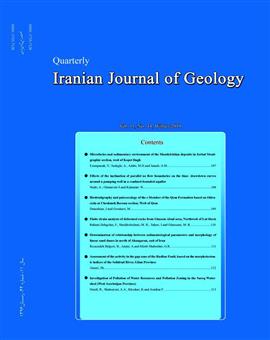تاثیر شیب مرزهای نفوذناپذیر در منحنی افت-زمان در اطراف یک چاه پمپاژ در آبخوان¬های محبوس
الموضوعات :آرش ندری 1 , عزت اله قنواتی 2 , نصرالله کلانتری 3
1 - دانشگاه شهید چمران اهواز
2 - خوارزمی
3 - دانشگاه شهید چمران اهواز
الکلمات المفتاحية: مرزهای نفوذناپذیر داده¬, های افت- زمان آبخوان محبوس شبیهسازی عددی چاه¬, های مجازی ,
ملخص المقالة :
بررسی تاثیر مرزهای نفوذناپذیر بر جریان به چاه های نزدیک به آن با استفاده از تئوری چاه های مجازی انجام می گیرد. در مواردی که مرزهای نفوذناپذیر مطالعه شده اند، این مرزها بهصورت عمودی در نظر گرفته شده اند درحالیکه در بسیاری موارد عمودی نبوده و شیب دار هستند. در این مطالعه هدف بر آن است که تاثیر شیب مرزهای نفوذناپذیر بر جریان به چاه در یک آبخوان محبوس بررسی شود. در این مطالعه شبیه سازی عددی و نیز محاسبات افت با استفاده از روش چاه های مجازی برای مرزهای عمودی انجام شده و سپس شبیه سازی جریان برای مرزهای شیبدار انجام شد. مدل مفهومی مورد نظر شامل یک آبخوان محبوس است که توسط دو مرز نفوذناپذیر محصور شده است و یک چاه با دبی ثابت در آن پمپاژ می شود. فاصله بین مرزها در فاصلهای از400 تا 10000 متر قرار گرفته است. شبیه سازی نشان داد که درصورتیکه مرزهای نفوذناپذیر و محدودکننده عمودی باشند تطابق بسیار عالی بین نتایج شبیهسازی عددی ازیکطرف و استفاده از رابطه تایس و تئوری چاه های مجازی از طرف دیگر وجود دارد. منحنی های افت زمان برای مرزهای نفوذناپذیر شیبدار تفاوت قابلتوجهی در زوایای مختلف و نیز عرض های مختلف (10000 تا 400 متر) با نتایج حاصل از مرزهای عمودی نشان دادند. نتایج نشان داد اگر فاصله مرزهای نفوذناپذیر زیاد باشد و مرزهای نفوذناپذیر دارای زوایای کمتر از 30 درجه باشند، تفاوت ها به حدی است که تقریب استفاده از روش چاه های مجازی می تواند قابلقبول باشد. اما هنگامیکه فاصله بین مرزها کمتر باشد حتی در زوایای کم نیز تفاوت قابلملاحظهای در مقادیر افت- زمان مرزهای شیبدار با نتایج روش چاه های مجازی وجود دارد.
Barrash, W. and Dougherty, M. E., 1997. Modeling Axially Symmetric and Nonsymmetric Flow to a Well with MODFLOW, and Application to Goddard2 Well Test, Boise, Idaho. Ground Water, 35, 602–611.
Chan Y. K., 1976. Improved image-well technique for aquifer analysis. Journal of Hydrology, 29 (1), 149-164.
Chen, Y., Yeh, H., and Yang, S., 2009. Analytical Solutions for Constant-Flux and Constant-Head Tests at a Finite-Diameter Well in a Wedge-Shaped Aquifer. Journal of Hydraulic Engineering, 133 (4), 333-337.
Davis, S. and Dewiest R., 1966. Hydrogeology. John Wiley and Sons. New York 463.
Dietz, D., 1943. De Toepassing van Invloedsfuncties bij het Berekenen van de Verlaging van het Grondwater ten Gevolge van Wateronttrekking. Water, 27 (6), 51-57.
Ferris, J. G., Knowles, D. B, Brown, R. H. and Stallman, R. W., 1962. Theory of aquifer tests. Water-Supply Paper 1536-E. US Geological Survey. United States Government Printing Office, Washington.
Forchheimer, P., 1886. Ueber die ergiebigkeit von brunnen-anlagen und sickerschlitzen. Zeitschr des Architekten-und Ingenieur-Vereines, 32, 539-563.
Hantush, M. S., 1959. Analysis of data from pumping wells near a river. Journal of Geophysical Research, 64(11), 1921-1932.
Harbaugh A. W., 2005. MODFLOW-2005, The U.S. Geological Survey Modular Ground-Water Model- the Ground-Water Flow Process. U.S. Geological Survey Techniques and Methods 6-A16
Intaraprasong T. and Zhan H. B., 2007. Capture zone between two streams. Journal of Hydrology, 338 (3–4), 297-307.
Kasenow, M., 1997. Ground-water Hydrology and Well Hydraulics. Water Resources Publications, LLC, Highlands Ranch, Colorado.
Kompani-Zare M. and Zhan H. B., 2005. Steady flow to a horizontal drain in an unconfined aquifer with variable thickness. Journal of Hydrology, 327 (1–2) 174-185.
Kompani-Zare M., Zhan H. B. and Samani N., 2004. Analytical study of capture zone of a horizontal well in a confined aquifer. Journal of Hydrology, 307 (1–4) 48-59.
Kruseman, G. P. and de Ridder, N. A., 1990. Analysis and Evaluation of Pumping Test Data (Second edition). Wageningen, the Netherlands: International Institute for Land Reclamation and Improvement. ISBN 90-70754-20-7.
Kuo, M. C. T., Wang, W. L., Lin, D. S. and Chiang, C. J., 1994. An image-well method for predicting drawdown distribution in aquifers with irregularly shaped boundaries. Ground Water, 32 (5), 794-804.
Lang, S., 1963. Drawdown patterns in aquifers having a straight-line boundary. Shortcuts and Special Problems in Aquifer Tests. US Geological Survey Water-Supply Paper: 56-68.
Moulder, E., 1963. Locus circles as an aid in the location of a hydrogeologic boundary. US Geological Survey Water-Supply Paper, 110-112.
Muskat, M., 1937. The Flow of Homogeneous Fluids through Porous Media. McGraw-Hill Book Company, Incorporated.
Reilly, T. E., 2004. A brief history of contributions to ground water hydrology by the US Geological Survey. Ground water, 42(4), 625-631.
Rubin, Y. and Dagan G., 1989. Stochastic analysis of boundaries effects on head spatial variability in heterogeneous aquifers: 2, impervious boundary. Water Recourses Research, 25(4), 707–712.
Samani, N. and Zarei-Doudeji S., 2012. Capture zone of a multi-well system in confined and unconfined wedge-shaped aquifers. Advances in Water Resources, 39 ,71-84.
Stallman, R. W., 1952. Nonequilibrium type curves modified for two-well systems. US Geological Survey, open-file chart (Ground Water Notes No. 3).
Stallman, R. W., 1963. Type curves for the solution of single-boundary problems. Bentall, Ray, Shortcuts and special problems in aquifer tests: US Geological Survey Water-Supply Paper: C45-C47.
Theis, C. V., 1935. The relation between the lowering of the piezometric surface and the rate and duration of discharge of a well using groundwater storage. Transactions of the American Geophysical Union 16, 519–524.
Todd, D. and Mays L., 2005. Groundwater Hydrology. Third edition, John Wiley and Sons, Inc.
Vandenberg, A., 1976. Tables and type curves for analysis of pump tests in leaky parallel-channel aquifers. Technical Bulletin no 96, Inland waters Directorate, Water Resources Branch, Ottawa.
Vandenberg, A., 1977. Type curves for analysis of pump tests in leaky strip aquifers. Journal of Hydrology. 33(1), 15-26.
Zarei-Doudeji, S. and Samani N., 2014. Capture zone of a multi-well system in bounded peninsula-shaped aquifers. Journal of Contaminant Hydrology 164, 114-124.


